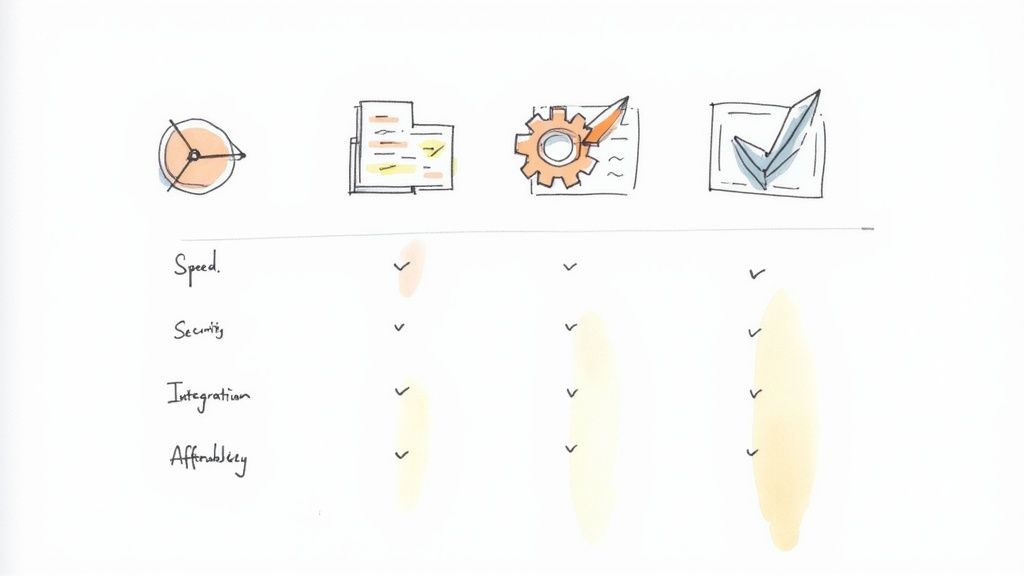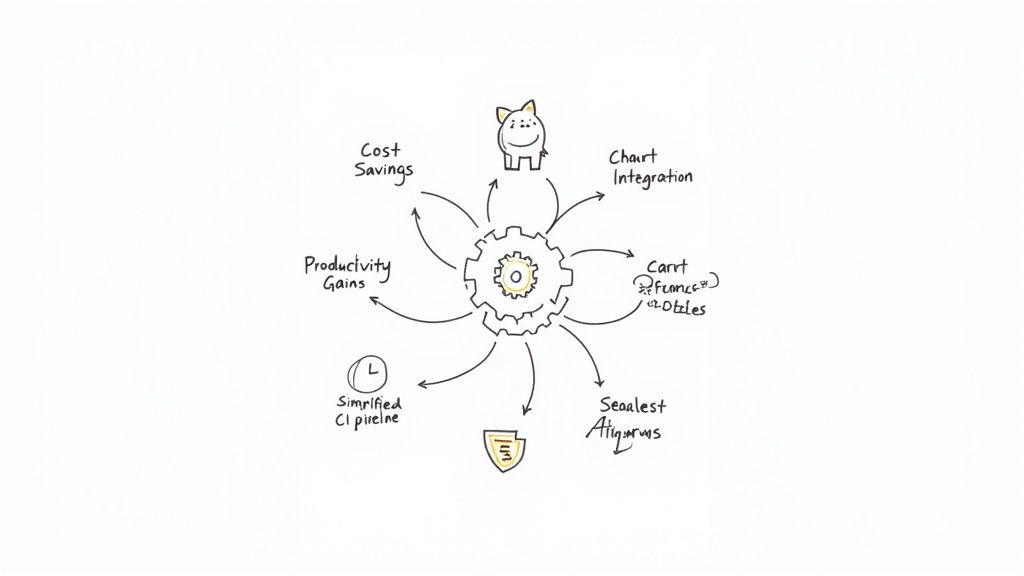Understanding Flaky Test Meaning: A Developer's Guide to Test Reliability

Breaking Down the Flaky Test Challenge

Every development team has encountered the frustration of flaky tests at some point. These tests pass sometimes and fail other times without any changes to the code, creating headaches for developers and testers alike. When teams can't rely on their test results, they may start dismissing failures as "just another flake" - potentially letting real bugs slip through into production.
Why Are Flaky Tests a Problem?
The uncertainty of flaky tests throws a wrench into the development process. Picture this: Your team is ready to ship an important feature, but the automated tests keep failing randomly. You spend hours running and re-running tests, trying to figure out if there's an actual bug or if the tests are just being temperamental. This eats up time that could be spent building new features or fixing legitimate issues. Recent research with 30 software practitioners confirmed what many teams already know - flaky tests seriously undermine the effectiveness of testing practices by muddying the waters around code quality.
The Real-World Impact of Flaky Tests
The problems caused by flaky tests go beyond day-to-day frustrations. Nearly 60% of developers report regularly struggling with unreliable tests, showing just how widespread this issue is. Even tech giants aren't immune - Google reports that 16% of their test suite exhibits flaky behavior, despite their substantial testing infrastructure. This instability erodes developers' faith in the testing process and slows down the entire development cycle.
Identifying True Flakiness
One of the trickiest aspects of dealing with flaky tests is determining whether a failure represents an actual problem. For instance, if a test that calls an external API fails, it could be due to temporary API downtime rather than a flaky test. On the other hand, failures caused by race conditions in the code are true examples of test flakiness. Getting to the bottom of test failures requires careful investigation of logs and execution patterns. Understanding these distinctions helps teams tackle flakiness effectively and build more reliable test suites. This knowledge forms the foundation for implementing solutions, which we'll explore in the following sections.
The Hidden Culprits Behind Test Flakiness
When a test fails inconsistently, there's usually more going on than meets the eye. While timing issues often get blamed first, numerous subtle factors can cause tests to behave unpredictably. In complex systems especially, small environmental changes can trigger unexpected test failures that are difficult to track down and fix.
Unstable Test Environments: A Breeding Ground for Flakiness
Test environment instability is one of the most common yet overlooked causes of flaky tests. This can show up in many forms - dependency conflicts, resource constraints, network issues, or database problems. A test might pass when calling an external API during low-traffic periods but fail during peak hours. Similarly, tests that need specific system resources like memory or disk space can fail randomly if those resources aren't consistently available. Even minor environmental variations can lead to test failures, which is why maintaining stable test environments is crucial.
Asynchronous Operations and Race Conditions
While asynchronous operations help applications perform better, they can make tests unreliable if not handled properly. When multiple operations run at the same time, race conditions often occur. For example, if a test checks a variable that gets updated asynchronously, the test might fail if it runs before the update finishes but pass if it runs after. This timing uncertainty makes race conditions particularly tricky to debug. The solution requires carefully ensuring that async operations complete before making test assertions.
Hidden Dependencies and Side Effects
Tests can also become flaky when they depend on or affect shared state. A test might rely on data created by previous tests - if the test order changes, it could fail. Similarly, tests that modify global variables or shared resources can cause other tests to fail unexpectedly. For instance, if one test changes a global setting, it might break later tests that assume a different value. Keeping tests isolated and minimizing side effects is key for reliability. You might be interested in: How to master your CI workflow.
Infrastructure Issues and External Factors
Even with perfect test code, infrastructure problems like network delays, database connectivity issues, and server instability can cause random failures. These factors are often outside developer control but still impact test results. A temporary network glitch could make a test fail even though the application works correctly. Third-party services add another layer of uncertainty - if an external API has downtime, tests that depend on it will fail. Managing these external dependencies requires robust error handling and fallback strategies.
By understanding these common causes of test flakiness, teams can take targeted steps to make their test suites more reliable. Recognizing how flakiness sneaks into tests helps developers prevent it proactively rather than just reacting to failures. The key is building robust test environments and practices that account for these hidden factors from the start.
When Good Tests Go Bad: Impact on Team Dynamics

Flaky tests do more than just cause technical headaches - they can seriously damage how development teams work together. When tests give unpredictable results, it creates real problems with trust between team members and slows down the entire development process. The effects ripple through project timelines, software quality, and team morale.
The Erosion of Trust
Consider what happens when test results become unreliable. Developers start doubting whether any test failures are real anymore, much like the story of the boy who cried wolf. Soon enough, they might ignore or dismiss actual bugs as just another flaky test acting up. This breakdown in trust spreads beyond just the tests - it makes people question the whole development process and their colleagues' work.
The Productivity Drain
The time cost of flaky tests adds up quickly. Instead of building new features or fixing real issues, developers get stuck running tests over and over, trying to figure out if failures are genuine problems or just random glitches. Recent research involving 30 development teams found that dealing with unreliable tests often added days or even weeks to project schedules. That's valuable time lost to what amounts to technical busywork.
Impact on Morale and Collaboration
Working with unreliable tests day after day takes a real toll on how people feel about their work. Developers can feel unfairly blamed when tests fail randomly, while QA engineers may think their valid concerns get brushed off. This creates tension between team members who should be working together smoothly. The constant uncertainty and finger-pointing leads to stress and job dissatisfaction.
Fostering a Culture of Reliability
Teams can take practical steps to reduce how flaky tests affect their dynamics. The key is making reliable testing a true priority - treating flaky tests as serious problems that need immediate fixes, not just minor annoyances to work around. Clear processes help track down and fix unreliable tests quickly. When everyone understands why stable tests matter and works together to maintain them, it builds trust and unity. The same research showed that teams taking this approach improved their test reliability by 20% and saw clear gains in team morale. This shows that addressing flaky tests isn't just about fixing code - it's about supporting healthy team dynamics.
Mastering Flaky Test Detection
Finding and fixing problematic tests is one of the most challenging aspects of maintaining a test suite. When tests fail randomly and inconsistently, they erode trust in the entire testing process and waste valuable developer time. Rather than just blindly rerunning failed tests, successful teams employ several proven strategies to identify and isolate flaky tests before they become a bigger problem.
Intelligent Test Runners: A First Line of Defense
Smart test runners provide essential capabilities for catching flaky tests early. These tools do more than just run tests - they include features specifically designed to spot inconsistent behavior. For instance, many test runners can automatically run failed tests multiple times. When a test passes some runs but fails others without any code changes, that's a clear signal of flakiness. This automated approach is much more efficient than manual reruns and removes the guesswork from identifying problematic tests. Some advanced runners even analyze patterns across test runs to detect flaky behavior with greater accuracy.
Comprehensive Logging: Illuminating the Path to Reliability
Detailed logging is critical for understanding why tests behave inconsistently. Good logs capture not just pass/fail results, but also key information about the test environment and behavior. For instance, when testing API integrations, logs should include details about response times, error codes, and request/response data. This helps determine if failures stem from actual bugs or external factors like network issues. Recording the sequence of test execution is also important, as it can reveal hidden dependencies between tests that lead to flaky results.
Isolate and Conquer: Pinpointing the Source of Flakiness
When you suspect a test is flaky, running it in isolation is key to understanding why. This means executing the test separately from the main test suite in a controlled environment. For example, if a test interacts with a database, giving it a dedicated database instance eliminates potential conflicts with other tests. This focused approach makes it easier to debug by removing variables that could impact test behavior. Isolated runs also provide cleaner logs and metrics that speed up root cause analysis. By implementing these detection methods early, teams can address flaky tests before they undermine the entire test suite. This creates a foundation of reliable tests that developers can trust as they build and ship new features.
Building Your Flaky Test Prevention Strategy

The key to dealing with flaky tests is shifting from a reactive to a proactive mindset. Rather than constantly putting out fires, teams need to build reliability into their testing approach from day one. By understanding what makes tests flaky and taking concrete steps to prevent issues before they occur, you can create a testing foundation that helps your team deliver quality software more efficiently.
Designing for Reliability: Essential Practices
Building reliable tests requires careful planning and solid engineering practices, just like any other part of software development. Here are key practices that help prevent flaky behavior:
- Effective Test Isolation: Each test should run independently, without relying on other tests' states or results. Think of tests like sealed containers - what happens in one shouldn't affect another. Use unique test data and clean up resources after each test runs to maintain isolation.
- Managing Asynchronous Operations: Tests involving async operations need special care to avoid timing-related failures. Be explicit about waiting for operations to complete before making assertions. For example, when testing database updates, use proper wait mechanisms to confirm the changes are done before checking results.
- Robust Test Environments: Unstable environments often cause flaky tests. Set up test environments that closely match production, with consistent versions and resources. Using tools like Docker helps create stable, repeatable environments for testing. Just as you'd want to test drive a car in real-world conditions, your tests should run in environments that reflect actual usage.
Practical Steps for Preventing Flaky Tests
Here are concrete actions you can take to strengthen your testing strategy:
- Review Test Code Regularly: Test code deserves the same careful review as application code. Look for hidden dependencies between tests, shared state, or overly complex logic that might cause instability.
- Implement Clear Setup and Teardown Procedures: Start each test with a clean slate and restore the environment afterward. This prevents test pollution, where leftovers from one test interfere with another - like wiping a whiteboard clean between problems.
- Use Mocking Strategically: While mocking helps isolate tests from external dependencies, too much mocking can make tests unrealistic. Find the right balance between isolation and real-world behavior. Read also: How to master your CI workflow.
Building a Culture of Test Reliability
Preventing flaky tests requires more than just technical solutions - it needs a team culture that values reliable testing. When your team treats flaky tests as serious issues requiring immediate attention, you build confidence in your testing process. Recent studies show that 59% of development teams regularly struggle with flaky tests. By taking a proactive approach to test reliability, your team can stand out by delivering more predictable results and shipping features with greater confidence.
Maintaining Rock-Solid Test Reliability
Just like a garden needs regular care to flourish, maintaining reliable tests requires consistent attention and upkeep. Creating a robust test suite involves much more than the initial setup - it demands ongoing monitoring, efficient maintenance routines, and building a team culture focused on test reliability. By taking a proactive approach, you can prevent flaky tests from becoming a recurring problem and ensure your test suite remains effective.

Monitoring Test Health: Staying Ahead of the Curve
Regular monitoring plays a vital role in maintaining healthy tests. Keep track of key metrics and spot potential issues early by implementing these key strategies:
- Flaky Test Detection: Use tools that automatically identify inconsistent tests by analyzing results across multiple runs. For example, if a test passes 9 out of 10 times without code changes, it likely needs attention.
- Performance Monitoring: Watch test execution times closely. Sudden increases could signal problems like resource constraints or inefficient code. This data helps you optimize your test suite and maintain good performance.
- Environment Stability Checks: Keep a close eye on your test environments. Look for resource issues, dependency conflicts, and other factors that could cause unreliable results. A stable environment forms the foundation for consistent test outcomes.
Establishing Effective Maintenance Routines
Good maintenance habits prevent tests from becoming flaky. This means more than just fixing failures - it's about finding and addressing potential problems before they impact your development work.
- Regular Code Reviews: Give test code the same attention as your main application code. During reviews, look specifically for things that could cause instability, like hidden dependencies or overly complex logic.
- Refactoring Test Code: Tests can get messy over time. Clean them up regularly to keep them readable and maintainable. Remove duplicate code, simplify complex parts, and update outdated tests.
- Root Cause Analysis: When you find a flaky test, dig deep to understand why it's happening. Look through logs, study test patterns, and work with your team to find the real problem. This helps prevent similar issues in the future.
Building a Culture of Test Reliability
Creating reliable tests takes teamwork. Everyone needs to understand why test reliability matters and commit to good testing practices.
- Prioritize Test Maintenance: Make test upkeep a normal part of development. Set aside specific time to fix flaky tests and improve your test suite. For instance, dedicate part of each sprint to test maintenance to show its importance.
- Shared Ownership: Get everyone involved in maintaining tests. When both developers and testers feel responsible for test quality, it leads to better collaboration. Try using a rotation system for handling flaky tests.
- Continuous Improvement: Keep evaluating and improving your testing approach. Stay current with new testing tools and methods, and listen to team feedback. Learn more in our article about mastering your CI workflow.
By following these approaches, you can shift from reacting to test problems to preventing them. This leads to faster development, fewer issues in production, and more confidence when releasing software.
Ready to make your CI/CD process smoother and eliminate flaky test headaches? Try Mergify today and see how automated merge management can help!





